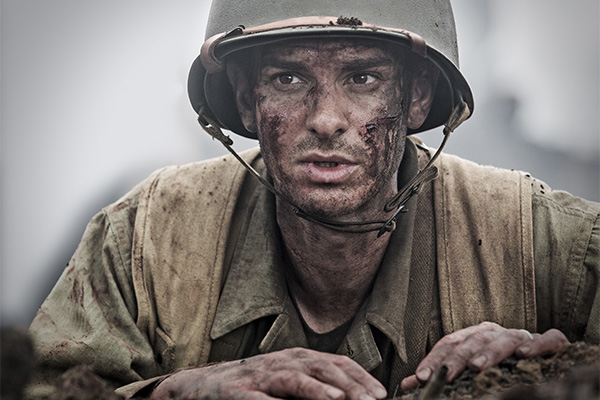Is it more conscientious to be an “objector” of than a “cooperator” in war?
Watching Hacksaw Ridge is an ordeal—and probably should be. War is hell. Any storytelling painting the picture otherwise is disingenuous. Even more so when the central character is a United States Army medic, charged with patching up his wounded and shattered comrades. But the portrayal of the battlefield horrors in this new biographical film render the heroism and the faithfulness of conscientious objector and Seventh-day Adventist Desmond Doss more troubling than inspiring.
After an arresting opening glimpse of the carnage to come but with a Bible verse that also hints at the story of faith, we get to know Doss, who grows up in an abusive home with a father damaged by past war. Faith and love play increasing roles in the story, coinciding with Doss enlisting to serve in the army as World War II takes grip of the world.
As we see more of Doss’ faith—portrayed in a way that shows rather than tells—the Bible is depicted as central. Doss is committed to Sabbath-keeping and his refusal to even touch a gun in training is the dominant tension. Doss always argued against his classification as a “conscientious objector”—he preferred “conscientious cooperator.” His stand is admirable. His determination to serve his country and fellow men in even the worst of circumstances is heroic. But the ordeal of the battlefield tests the assumptions we might prefer, the image of the American hero director Mel Gibson seeks to portray and how we as Adventists might respond to this film.
On a number of occasions, Doss is depicted being rescued from an attacking soldier by a bullet fired by one of his fellow soldiers. As viewers, we’re expected to applaud these deaths at the same time as honouring Doss’ commitment not to kill.Nathan Brown
The graphic rendering of the battle for Hacksaw Ridge—regarded as one of the bloodiest of the war—emphasises the absurdity of going into such an environment unarmed. Undoubtedly, Doss served faithfully and it seems God worked with his faithfulness to save both Doss and many of his men.
But this large-scale retelling of Doss’ story also raises questions about the conscientious role he played, whether cooperator or objector. On a number of occasions, Doss is depicted being rescued from an attacking soldier by a bullet fired by one of his fellow soldiers (it’s hardly a spoiler to report Doss survives the battle). As viewers, we’re expected to applaud these deaths at the same time as honouring Doss’ commitment not to kill.
And this is the tension. In his survey of different Christian stances in relation to war, John Howard Yoder singled out the traditional Seventh-day Adventist position as one of the most fraught: “The obligation is absolute, but it is also arbitrary. One can, like the Seventh Day Adventists [sic], refuse to kill and yet be willing to participate in the military enterprise, since it is only the act of doing the killing oneself which is forbidden.” (Nevertheless: The Varieties and Shortcomings of Religious Pacifism, Second Edition, Herald Press, 1976, page 96). Perhaps this “immature vision”—as Yoder describes it—has laid the groundwork for the growing abandonment of it by Adventist members of the military in some parts of the world.
But would Doss have been more faithful if he’d simply chosen to stay home, safely away from the war, as he had the option to do? Would he have been any less a beneficiary of those who were killing on behalf of his nation? And is this similar to the situation many of us find ourselves in as beneficiaries of the violence committed to ensure our freedom and lifestyles?
These questions are not answered simply. Doss’ story does little to help us with them, except to remind us our highest call is always to faithful service, to “conquer evil by doing good” (Romans 12:20, NLT), whenever and whatever our circumstances. While we might examine the theology of his stance, we cannot question the faithfulness and trust with which he did what he felt he was called to do.
But Hacksaw Ridge’s graphic depiction of the horrors and futility of war should also remind us of the Bible’s call to faithful peacemaking in the larger and the smaller contexts of our lives. When it comes to war and peace, the Bible offers stark alternatives: “Those who use the sword will die by the sword” (Matthew 26:52, NLT); or “those who work for peace . . . will be called the children of God” (Matthew 5:9, NLT), although this is certainly not a formula for everything to go smoothly, easily or safely.
Hacksaw Ridge should prompt us to ask whether it is more conscientious to be an “objector” than a “cooperator” with the tragic business of war. In a violent and conflicted world, we must continue to applaud faithfulness and service. But we must also find ways to champion faithful, courageous and creative peacemaking wherever it can be found and fostered.
Share

